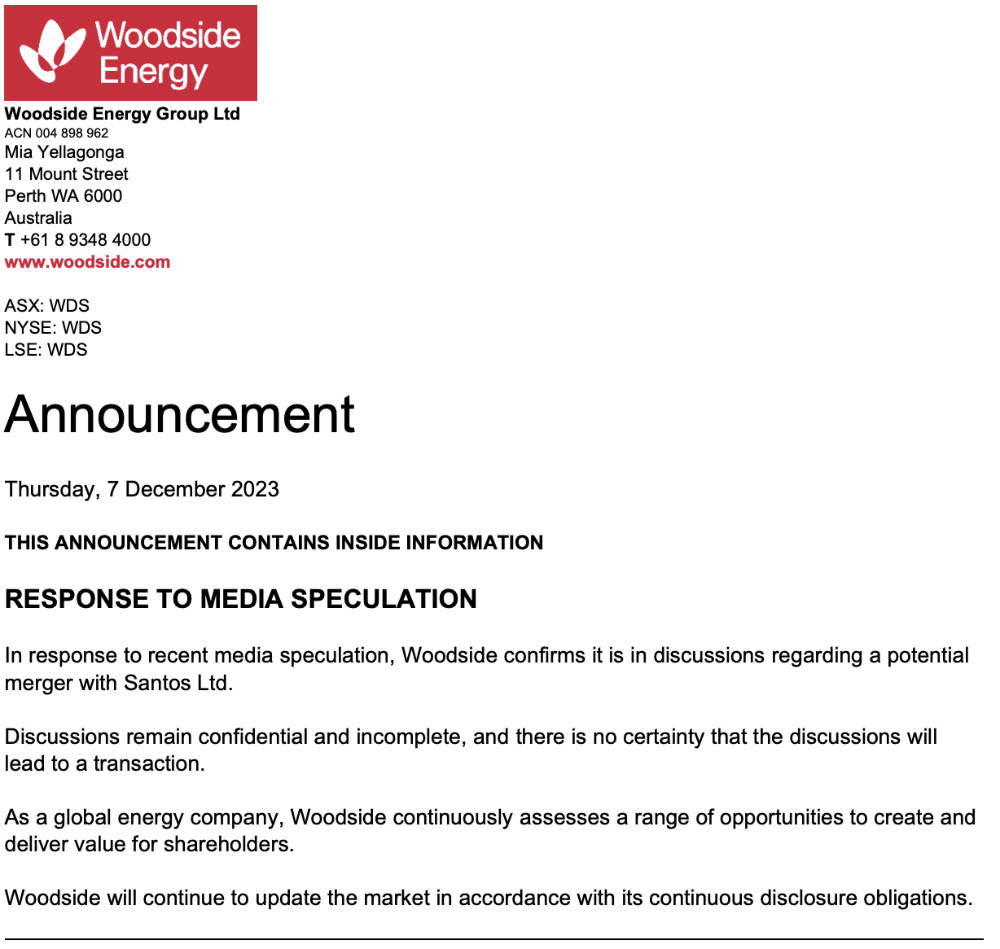A Woodside, Santos marriage is in the works – what will a merged company look like?

Why by no means certain, a merger between Woodside and Santos is in the works. Pic: via Getty Images.
There is little doubt that operating in the oil and gas industry has become increasingly challenging, necessitating companies to adapt in order to survive.
The two key strategies adopted by companies are either to be nimble enough to take advantage of market trends – a trait normally found in smaller companies, or to get big enough to push big projects through to fruition.
Australia’s two largest gas companies, Woodside (ASX:WDS) and Santos (ASX:STO) – both of which are less than two years out from their respective major M&A transactions – clearly favour the second option, announcing to the ASX their media speculations about a potential merger are accurate but that everything is still at an early stage and it might not result in a material transaction.

So just what would a merger between Woodside and Santos look like?
For starters, the merged company (Woodtos? Sanside?) will have a market capitalisation of $80bn, large enough to compete with the major independents though still shy of the big supermajors like ExxonMobil, Shell, BP and Chevron.
It certainly provides it with the financial wherewithal to progress projects that are currently being developed and to pursue new projects.
Both companies also have – rather fittingly – a strong base of production and development assets in Australia.
Amongst other things, Woodside is of course best known for its LNG export projects – the North West Shelf and Pluto LNG.
It is also in the process of developing the massive Scarborough gas field, though this has faced intense resistance.
Santos is also an Australian LNG exporter through its interest in Gladstone LNG and has gas production assets in the Cooper Basin as well as in Queensland and NSW.
Like Woodside, the company is also facing strong opposition getting its Barossa gas field past the line.
Global presence
Besides their Australian operations, both companies have operations across the globe.
Outside of domestic production, Woodside has a range of production assets (from its acquisition of BHP Petroleum) in the Gulf of Mexico – including the Mad Dog field – along with the Angostura, Ruby and Calypso fields in Trinidad and Tobago.
It is currently developing the Sangomar oil project in Senegal that is targeted for start-up in mid-2024 and the Trion field in Mexico where first oil is expected in 2028.
Santos also has a significant interest in the PNG LNG project and is developing the Pikka project in Alaska – both acquired as part of the merger with Oil Search.
It is also making good progress with its Moomba carbon capture and storage project, which is expected to begin CO2 injection in the first half of 2024.
Should it work as planned, which is the real challenge given the difficulties faced by other CCS projects such as at Chevron’s Gorgon LNG project, Moomba CCS will be capable of storing up to 1.8Mt of CO2 per annum. That’s more than 25% of total emissions produced by Australia’s electricity sector in the full year to March 2023.
That the two companies have these and other projects across the global is especially important for the proposed merger as it provides them with options to deliver continued production and cash flow – options that are looking increasingly valuable as their major Australian projects struggle against a hostile environment.
Merger challenges
A merger between Woodside and Santos isn’t all sunshine and rainbows though.
One of the thorny questions to be asked would be who would lead the combined company? A question complicated by Santos’ Kevin Gallagher being touted at one point as a potential chief executive for Woodside.
Bringing Australia’s two largest ASX-listed gas companies together in matrimony could also draw the attention of the Australian Competition & Consumer Commission (ACCC), which would likely be concerned about the impact of less competition in the gas sector.
While Woodside is typically seen as west coast focused and Santos its east coast counterpart, both companies actually have significant assets in each other’s home ground, so concern from the ACCC isn’t unlikely.
However, there’s an argument here that a merged company wouldn’t be competing against other gas companies, rather a broader perspective needs to be taken, which makes its real competitors the constantly growing renewable energy sector.
Should that be the case, then Woodside and Santos will likely need every bit of firepower they can muster.
UNLOCK INSIGHTS
Discover the untold stories of emerging ASX stocks.
Daily news and expert analysis, it's free to subscribe.
By proceeding, you confirm you understand that we handle personal information in accordance with our Privacy Policy.








